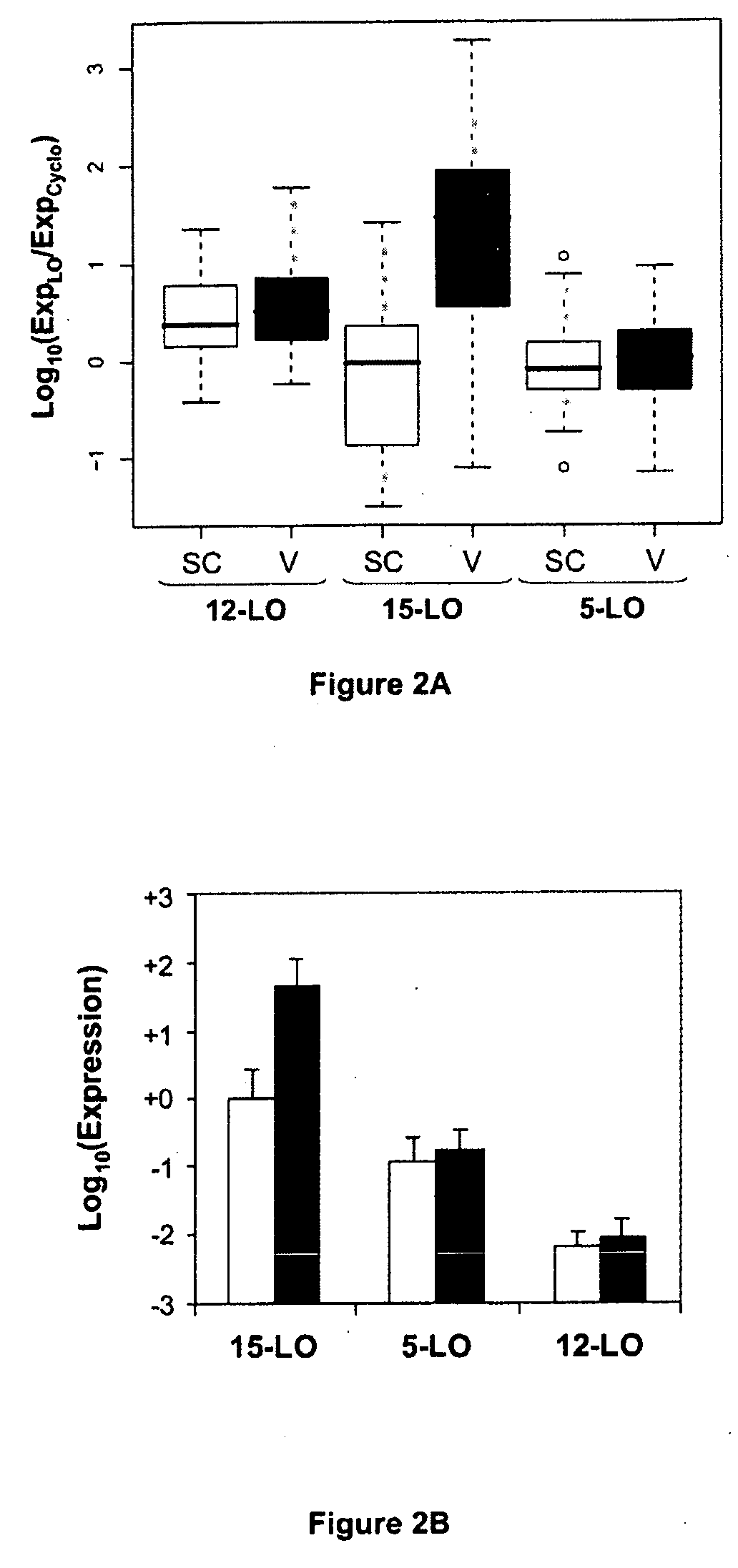Use of 15-Lipoxygenase Inhibitors for Treating Obesity
a technology of lipoxygenase inhibitor and 15-lipoxygenase, which is applied in the direction of drug composition, antibody medical ingredients, metabolic disorders, etc., can solve the problems of increasing the risk of developing other health problems, and the current pharmacological approach has the drawback of causing more or less tolerable side effects
- Summary
- Abstract
- Description
- Claims
- Application Information
AI Technical Summary
Benefits of technology
Problems solved by technology
Method used
Image
Examples
example 1
Demonstration of Specific Overexpression of the 15-LO-1 Gene in Human Abdominal Visceral Adipose Tissue (AT) as Compared to Human Abdominal Subcutaneous at in a Group of 10 Men by DNA Chip Technology and by RT-PCR
Tissue Harvesting
[0107]In accordance with the Huriet Law relating to the protection of persons participating in biomedical research, signed informed consent was obtained from each patient before tissues were collected. Demographic and clinical data on the patients were also obtained. For each patient, abdominal visceral AT (omentum) and abdominal subcutaneous AT were harvested during abdominal surgery. Skin and blood vessels were immediately removed from the tissue with surgical scissors and the resulting AT samples were cut into small pieces and immediately frozen in liquid nitrogen.
Extraction of Total RNA from AT
[0108]RNA is extracted from AT by the modified guanidium thiocyanate method. Total RNA was treated with DNAse 1 to eliminate any traces of contaminating genomic D...
example 2
Confirmation of Specific Expression of the 15-LO-1 Gene in Human Abdominal Visceral AT Relative to Human Abdominal Subcutaneous AT, by Quantitative PCR on a Group of 83 Patients, and Selectivity of Said Specific Expression Relative to Other Lipoxygenases
Tissue Harvesting and RNA Extraction
[0115]The results obtained by DNA chip technology were confirmed on abdominal visceral and subcutaneous AT from a group of 83 patients (see Table 4 for clinical data on the patients). Tissues were harvested and RNA extracted as in example 1.
TABLE 4PatientTotalLDLHDLTotalIdentifi-cholesterolcholesterolcholesteroltriglyceridescationSexBMI(g / l)(g / l)(g / l)(g / l)16F33.31.430.710.421.4117F17.92.391.490.551.7021M28.42.031.460.231.7423F25.51.450.890.271.4224F25.22.601.510.582.5725F21.91.571.000.201.8631M28.11.270.700.311.2833F23.91.560.820.600.6936F20.90.310.270.010.1237M28.31.060.380.421.2939M24.91.130.500.401.1540M20.50.740.440.220.3741M27.00.890.540.250.5042M17.80.470.360.030.4543M21.31.880.900.621.8144F2...
example 3
15-LO-1 Expression is Detected in the Different Fractions of Human AT, Including in Adipocytes and Pre-Adipocytes, and Appears to be the Major Form in the Vascular Stroma Fraction
Isolation of Different Human AT Fractions
[0124]AT are harvested as described in example 1. After removing skin and vasculature, the AT fragments to be used in tissue fractionation are immediately washed in PBS solution supplemented with a penicillin / streptomycin mixture (100 U / 100 μg / ml) at 37° C., then incubated in Falcon tubes in digestion buffer (Krebs Ringer buffer 9.5 g / l; 25 mM Hepes; bovine serum albumin 20 mg / ml; 5 mM glucose (Sigma); type 1 collagenase 1.5 mg / ml (Gibco)) with a ratio of AT mass / digestion buffer of 1 g per 10 ml, for 45 minutes at 37° C. with shaking. Digestion lysates are then filtered on a nylon filter (200 μm pore size) to remove any remaining undigested tissue (=matrix or CM). The resulting cell suspension is centrifuged for 15 minutes at 800 g to separate floating adipocytes (f...
PUM
| Property | Measurement | Unit |
|---|---|---|
| Antisense | aaaaa | aaaaa |
Abstract
Description
Claims
Application Information
 Login to View More
Login to View More - R&D
- Intellectual Property
- Life Sciences
- Materials
- Tech Scout
- Unparalleled Data Quality
- Higher Quality Content
- 60% Fewer Hallucinations
Browse by: Latest US Patents, China's latest patents, Technical Efficacy Thesaurus, Application Domain, Technology Topic, Popular Technical Reports.
© 2025 PatSnap. All rights reserved.Legal|Privacy policy|Modern Slavery Act Transparency Statement|Sitemap|About US| Contact US: help@patsnap.com



